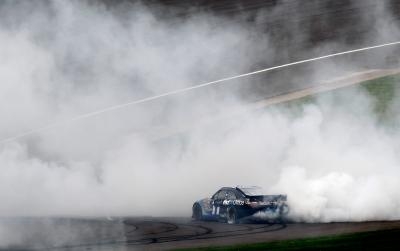
"Wiing, wiing, wiiinnng, wiiiiiiiinnnnng, Chirp." Ahh, the siren call of a front-wheel-drive burnout, so often a cacophony of sound and thunder with little in the way of smoke or fury. Front-drivers are, almost by definition, less powerful than rear-drivers. The FWD drivetrain simply doesn't lend itself either to handling or traction in a straight line, so manufacturers tend to keep the chassis' bad behavior at bay by using engines with more high-rpm horsepower than low-rpm torque. This makes productive burnouts a bit more difficult to initiate, but can make them easier to sustain.
Park the car on a level surface, which will of course be the burnout box at a dragstrip. No law-abiding citizen would consider doing a burnout anywhere else, because that would be illegal. Concrete pads and metal plates at a dragstrip are the only places for performing a burnout. Doing so on a typical road or in a parking lot may well end up peppering your fenders with rocks and molten asphalt, which is one more reason not to do it.
Pour water from a five-gallon bucket or hose in front of the tires, then pull the car forward onto the puddle. If you're at a dragstrip (and of course you are), then drive around any standing water in the burnout box and don't spray the whole track down when you water the tires. There's no sense in getting your rear tires wet and risk destabilizing the car when all you need is a bit of water on the fronts.
Set the parking brake, and raise rpm to halfway between your engine's torque and horsepower peaks. If you don't have engine data available, then 3,500 to 4,000 should do it. Light cars with larger engines, heavy flywheels and skinny tires can initiate a burnout at closer to the torque peak, while heavy cars with a small-displacement engine, lightweight flywheel and fat tires will need a bit more engine inertia to get things moving.
Let the clutch out, but don't drop it completely as you would when shifting gears. A sudden shock will help to get the tires moving, but if they fail to spin then you stand an excellent chance of breaking something expensive. Let the clutch out in about 1/3 the amount of time that you would for a smooth launch on the street, which is to say about 0.5 to 1.00 second.
Stab the throttle to keep engine rpm up as the clutch engages. Inertia is key here; allow the engine to drop below its torque peak and you may not be able to sustain the burnout. Once you have the clutch fully out, raise rpm to just shy of your horsepower peak to keep the tires spinning.
Keep the burnout going until you've created a thoroughly impressive cloud of smoke or blown the engine to bits.